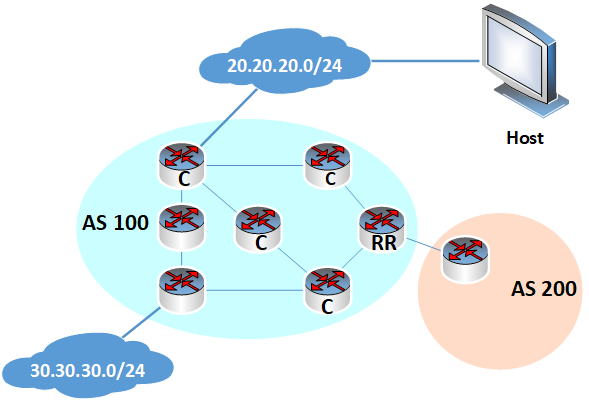In BGP (Border Gateway Protocol), when routers within the same Autonomous System (AS) exchange routes using iBGP, there’s a key requirement: full mesh peering. Every iBGP router must form a peering with every other iBGP router in the AS. While this works in small networks, it becomes extremely inefficient and unmanageable in larger environments due to the exponential growth in peerings.
To solve this scalability issue, Route Reflectors (RRs) are introduced.
The Full Mesh Requirement Problem
In a standard iBGP setup, if you have n routers in an AS, each one needs to peer with (n-1) others. For example, with 10 routers, you’d need 45 individual peerings. As the network grows, the number of required connections becomes a major challenge.
This is where Route Reflectors come in. They allow network designers to avoid the full mesh requirement, making iBGP more scalable and manageable.
What Is a Route Reflector?
A Route Reflector is a specially configured iBGP router that acts as a central point for distributing routing information. Instead of requiring all iBGP routers to peer with each other, they simply peer with the Route Reflector. The RR then “reflects” route updates between them.
The concept is somewhat similar in function to the Designated Router (DR) in OSPF—centralizing communication to reduce overhead. However, Route Reflectors are manually configured and behave differently under the hood.
Roles in a Route Reflector Topology
When using Route Reflectors, iBGP routers fall into three categories:
- Route Reflector (RR): The router responsible for reflecting routes.
- RR Clients: Routers that peer directly with the RR. They do not need to peer with each other.
- Non-Clients: iBGP routers that are not clients of any RR. These still require a full mesh between themselves and with the RR.
Route Reflector Peerings
A Route Reflector can have three types of BGP peerings:
- eBGP Peers – External peers from a different AS.
- RR Clients – Internal iBGP peers designated as clients.
- Non-Clients – Internal iBGP peers not configured as clients.
Understanding these relationships helps explain how route propagation works in such a setup.

How Route Reflectors Advertise Routes
Route Reflectors follow specific rules when it comes to advertising routes:
- Route from a Non-Client → Advertised to RR Clients only.
It is not advertised to other non-clients to avoid violating the iBGP split horizon rule. - Route from an RR Client → Advertised to both other RR Clients and Non-Clients.
- Route from an eBGP Peer → Advertised to both RR Clients and Non-Clients.
Example:
If a non-client router advertises the network 30.30.30.0/24 to the RR, the RR will send it to its clients but not to other non-clients.
If a client advertises 20.20.20.0/24, the RR will reflect it to all clients and non-clients.
Similarly, any route received from an eBGP neighbor will be shared with every iBGP router in the AS.
Design Considerations and Loop Prevention
There are a few things to consider when working with Route Reflectors:
- Manual Configuration: Unlike other routing protocols where certain roles are dynamically elected, Route Reflector roles must be manually assigned.
- Redundancy: You can configure multiple RRs for high availability. RR clients can be configured to peer with more than one RR to prevent single points of failure.
- Loop Prevention: Since RRs relax the iBGP split horizon rule, BGP uses two special attributes—Originator ID and Cluster List—to prevent routing loops. These fields help routers identify the source of a route and whether it has already been seen.
Summary
Route Reflectors are essential for scaling iBGP in large networks. By eliminating the full mesh requirement, they simplify configuration, reduce overhead, and maintain efficient route distribution. However, they must be deployed carefully with attention to redundancy and loop prevention.
Understanding the role of Route Reflectors—and how routes are exchanged among clients, non-clients, and eBGP peers—provides a strong foundation for designing robust BGP topologies.
Also read: VXLAN – Encapsulation, Headers, and the Packet Transmission Process
About:
Welcome to telecomTech, where telecom and networking technologies… are simply explained! I’m Lazarus, a telecom professional with over 25 years of experience in network design, architecture, and telecom technologies. Over my career, I’ve led major projects, trained professionals, and helped countless individuals earn certifications and advance their careers.
My goal is to make networking and telecom concepts clear, practical, and engaging—the way I wish they were taught when I started learning!
Whether you’re a student, a professional growing your skills, or preparing for certifications like Cisco, telecomTech is here to guide you.
Join me as we explore telecom and networking as a lifelong passion, not just a job. Let’s make this journey of growth and discovery together!

